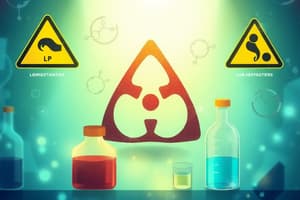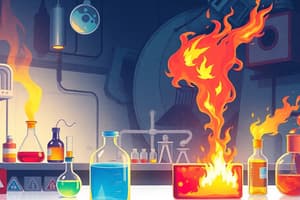Podcast
Questions and Answers
Which of the following is the MOST important action to take before working with any chemical?
Which of the following is the MOST important action to take before working with any chemical?
- Checking the chemical labels (correct)
- Consulting a colleague
- Preparing the necessary equipment
- Ensuring proper ventilation
According to regulations, chemical containers must have appropriate warning labels.
According to regulations, chemical containers must have appropriate warning labels.
True (A)
What does the 'O' code on a chemical label represent?
What does the 'O' code on a chemical label represent?
Oxidizing
The 'E' code on a chemical label stands for ______.
The 'E' code on a chemical label stands for ______.
Match the chemical hazard symbol with its corresponding hazard type:
Match the chemical hazard symbol with its corresponding hazard type:
What is the primary concern associated with chemicals labeled as 'N'?
What is the primary concern associated with chemicals labeled as 'N'?
It is acceptable to dispose of chemicals labeled 'N' through regular waste disposal methods.
It is acceptable to dispose of chemicals labeled 'N' through regular waste disposal methods.
What does the 'C' code on a chemical label signify?
What does the 'C' code on a chemical label signify?
Extremely flammable substances have a flash point below ______ °C and a boiling point below 35°C.
Extremely flammable substances have a flash point below ______ °C and a boiling point below 35°C.
Match the hazard statement with the appropriate precautionary measure:
Match the hazard statement with the appropriate precautionary measure:
If a chemical is labeled 'Xn', what type of hazard does it represent?
If a chemical is labeled 'Xn', what type of hazard does it represent?
When handling chemicals, it is always safe to remove labels from containers to avoid confusion.
When handling chemicals, it is always safe to remove labels from containers to avoid confusion.
What does the 'Xi' code represent on a chemical label?
What does the 'Xi' code represent on a chemical label?
Chemicals that are labeled with a 'T' are considered to be ______.
Chemicals that are labeled with a 'T' are considered to be ______.
Match the color-coded hazard rating with its corresponding hazard type:
Match the color-coded hazard rating with its corresponding hazard type:
What is the significance of the red area on a product label's hazard diamond?
What is the significance of the red area on a product label's hazard diamond?
A chemical with a '0' rating in the yellow reactivity section is considered stable.
A chemical with a '0' rating in the yellow reactivity section is considered stable.
What does the "W" symbol in the white section of a chemical label indicate?
What does the "W" symbol in the white section of a chemical label indicate?
The blue area on a hazard diamond indicates the ______ hazard rating.
The blue area on a hazard diamond indicates the ______ hazard rating.
Match the pictograms with the corresponding hazard categories:
Match the pictograms with the corresponding hazard categories:
What is the regulatory purpose of Material Safety Data Sheets (MSDS)?
What is the regulatory purpose of Material Safety Data Sheets (MSDS)?
MSDS's are generally tailored for easy understanding and lab-specific use.
MSDS's are generally tailored for easy understanding and lab-specific use.
What type of information should be easily accessible in a lab regarding chemical safety?
What type of information should be easily accessible in a lab regarding chemical safety?
Will have ______ signs on the label.
Will have ______ signs on the label.
Match the chemical with its potential dangers
Match the chemical with its potential dangers
Flashcards
Why check chemical labels?
Why check chemical labels?
Labels on chemical containers provide crucial information about the chemicals and their hazards.
What does an 'oxidizing' label mean?
What does an 'oxidizing' label mean?
Chemicals with this symbol can react exothermically even without oxygen, posing a fire risk.
What does an 'explosive' label mean?
What does an 'explosive' label mean?
Chemicals with this label may react exothermically, potentially exploding upon heating or impact.
What does a 'corrosive' label mean?
What does a 'corrosive' label mean?
Signup and view all the flashcards
What does 'dangerous to the environment' mean?
What does 'dangerous to the environment' mean?
Signup and view all the flashcards
Extremely flammable substances (F+)
Extremely flammable substances (F+)
Signup and view all the flashcards
What does an 'irritant' label mean?
What does an 'irritant' label mean?
Signup and view all the flashcards
What does a 'toxic' label mean?
What does a 'toxic' label mean?
Signup and view all the flashcards
What does RED indicate?
What does RED indicate?
Signup and view all the flashcards
What does YELLOW indicate?
What does YELLOW indicate?
Signup and view all the flashcards
What are Material Safety Data Sheets?
What are Material Safety Data Sheets?
Signup and view all the flashcards
Study Notes
- Chemical hazards are present in the laboratory setting.
Chemical Handling and Label Requirements
- It's essential to understand the hazards associated with chemicals.
- It's important to know the actions that could happen involving chemicals
- It's important to understand what to do in case of chemical accident
- Prioritize reading warning labels on all containers before use.
- Labels must have warning signs - required by law.
- Labels must be classified internationally.
Codes on Labels
- "O" indicates oxidizing agents.
Explosive Chemicals
- "E" signifies explosive substances.
- Explosive chemicals might react exothermically without oxygen.
- Explosive chemicals may emit gases which could explode if heated.
- Avoid impact, friction, sparks, fire, and heat when handling explosive chemicals.
Corrosive Chemicals
- "C" represents corrosive substances.
- Corrosive chemicals can destroy living tissues upon contact.
- When handling corrosive chemicals protect skin, eyes, and clothing.
- Avoid inhalation and seek medical help if feeling unwell.
Environmental Hazards
- "N" indicates substances dangerous to the environment.
- Leaking these substances damages the environment immediately or in the long term
- Avoid disposing of these chemicals through regular waste systems.
- Utilize specialized waste disposal companies and follow all disposal instructions.
Flammable Chemicals
- "F" denotes flammable materials.
- Extremely flammable substances (F+) have a flash point below 0°C and a boiling point below 35°C.
- Keep away from flames, ignition sources, sparks, and heat, and ensure good ventilation.
Harmful Chemicals
- "Xn" identifies harmful chemicals which may cause death or acute chronic effects via inhalation, swallowing, or skin absorption.
- These chemicals may be carcinogenic or mutagenic and may have a reproductive toxic effect.
- Avoid any contact with harmful chemicals.
Irritant Chemicals
- "Xi" marks irritant chemicals capable of causing acute or chronic irritation through short, prolonged, or repetitive exposure, potentially causing skin sensations.
- Avoid skin and eye contact, and do not inhale irritant chemicals.
Toxic Chemicals
- "T" signifies toxic chemicals, where even small quantities can be lethal or cause severe damage to health.
- When handling toxic chemicals, avoid all forms of contact.
- Seek immediate medical help if feeling unwell.
Health Warning Labels
- 4 is a Danger: May be fatal upon short exposure, wear special protection
- 3 is a Warning: Corrosive or toxic and to avoid skin contact or inhalation
- 2 is a Warning: may be harmful when inhaled or absorbed
- 1 is a Caution: may be irritating
- 0 is No unusual hazard
Red: Flammability Ratings
- 4 means Danger: Flammable gas or extremely flammable liquid.
- 3 means Warning: Flammable liquid flash point below 100ºF (38ºC).
- 2 means Caution: Combustible liquid with flashpoint between 100 and 200ºF (38 - 93ºC).
- 1 is Combustible if heated.
- 0 is Not combustible.
Yellow : Reactivity Ratings
- 4 is Danger: Explosive material at room temperature.
- 3 is Danger: Explosive if shocked, heated under confinement, or mixed with water.
- 2 is Warning: Unstable or may react violently when mixed with water.
- 1 is Caution: May react with heat of if mixed with water, but not violently.
- 0 is Stable: No reaction when mixed with water.
White Label Notice Meanings
- "W" stands for water-reactive
- "Oxy" indicates an oxidizing reagent
Material Safety Data Sheets (MSDS)
- All chemicals must have MSDS's which is required by the law.
- MSDS are provided by the manufacturer.
- MSDS are often written for industrial applications and not suitable for lab use.
- Labs should have a file or internet access to MSDS's that can easily be accessed.
Studying That Suits You
Use AI to generate personalized quizzes and flashcards to suit your learning preferences.




